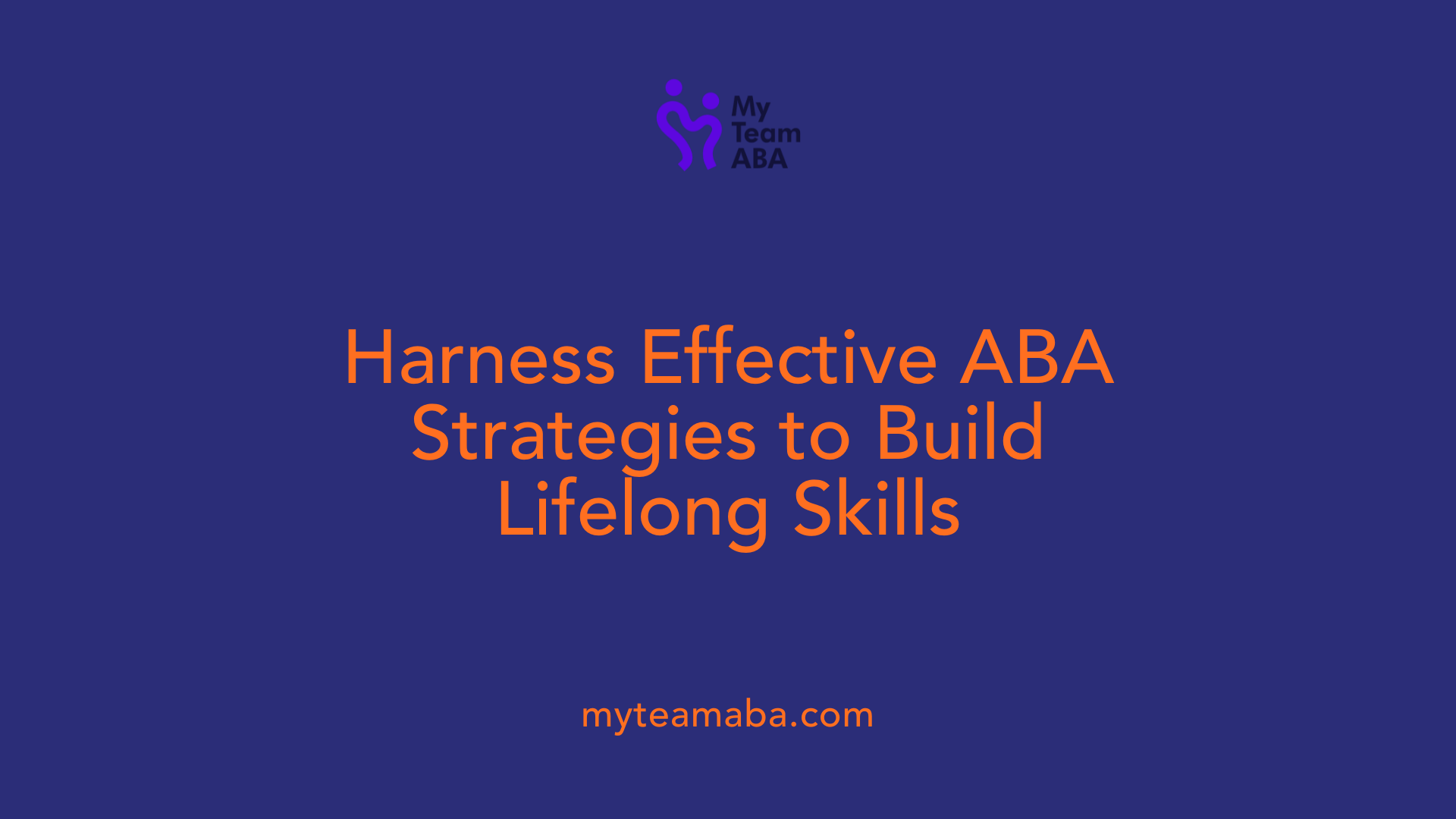How ABA Therapy Encourages Independence in Daily Tasks
August 1, 2025
Fostering Autonomy: The Power of ABA in Building Daily Life Skills

Unlocking Independence Through Structured Interventions
Applied Behavior Analysis (ABA) is a proven approach to helping children with autism develop crucial life skills and gain independence in their daily routines. By breaking down complex tasks into manageable steps, utilizing visual supports, and reinforcing positive behaviors, ABA therapy empowers children to perform everyday activities with confidence and autonomy. This article explores how ABA supports independence across various daily tasks, from personal hygiene to household chores, and highlights effective strategies that caregivers and educators can apply.
The Foundations of ABA in Developing Daily Skills

What is ABA therapy?
Applied Behavior Analysis (ABA) therapy is a scientific approach rooted in understanding how behavior works. It involves using evidence-based techniques to teach new skills and improve existing behaviors. For children with autism, ABA provides a structured way to help them navigate daily routines more easily and with greater independence.
How does ABA support independence in daily tasks for children with autism?
ABA therapy enhances independence by teaching essential life skills such as dressing, personal hygiene, and meal preparation. The process begins with task analysis, which involves breaking down complex activities into small, manageable steps like waking up, brushing teeth, or getting dressed.
Therapists employ positive reinforcement — rewarding desired behaviors with praise or tokens — to motivate children. Visual supports like picture cards and checklists make routines clearer, helping children understand what to do next. As children practice, prompts and modeling support their learning, which are gradually faded to foster independence.
Parents and therapists work together to track progress, adapt strategies, and celebrate small successes. This ongoing process helps children generalize skills across various settings, building their confidence and life skills over time.
What techniques does ABA therapy use to foster self-sufficiency in children with autism?
ABA employs several techniques to promote independence. Task analysis breaks down complex skills into smaller steps, making them easier to learn. Prompting, modeling, and visual cues guide children through tasks, with prompts gradually reduced as they become more confident.
Reinforcement strategies are central; desirable behaviors are rewarded to encourage repetition and mastery. Techniques such as differential reinforcement (DRA, DRO, DRI) help teach specific skills while reducing undesired behaviors.
Visual supports like schedules, picture exchange systems, and timers organize routines and assist communication, reducing anxiety and helping children feel secure.
Teaching replacement behaviors, using social stories, and simulating real-life situations through Natural Environment Teaching (NET) are other methods that increase self-sufficiency and ensure skills are practical and applicable.
Addressing common challenges with ABA strategies
Children with autism often face difficulties with transitions, sensory sensitivities, and communication. ABA adapts to these challenges by incorporating sensory breaks, creating personalized visual supports, and fostering social skills through play-based learning.
Transition strategies include visual timers and social stories that prepare children for changes in routine. Sensory sensitivities are managed with calming routines and sensory-friendly materials. Communication barriers are addressed by introducing AAC devices and teaching social exchanges.
Consistency in applying these strategies across environments like home, school, and community creates a supportive network that encourages ongoing growth and independence.
| Aspect | Techniques | Purpose |
|---|---|---|
| Skill Breakdown | Task analysis | Improves focus and learning |
| Reinforcement | Praise, tokens, tangible rewards | Motivates independent behavior |
| Visual Supports | Schedules, picture cards, timers | Clarifies routines and reduces anxiety |
| Generalization | Natural environment teaching | Applies skills broadly |
| Addressing Barriers | Sensory breaks, social stories | Overcomes individual challenges |
ABA therapy’s tailored approach is highly effective in fostering independence. With patience, consistency, and strategic adjustments, children can master daily routines and develop essential skills for overall life success.
Strategies and Techniques in ABA to Foster Autonomy

What methods are recommended within ABA therapy to promote independence in daily routines?
ABA therapy employs several effective strategies to help children gain independence in everyday activities. One essential approach is breaking down complex routines into smaller, manageable steps through task analysis and chaining. This method allows children to learn each part of a task sequentially, building confidence and ensuring mastery.
Utilizing visual aids such as picture schedules, checklists, and icons makes routines clearer and easier to follow. These visual supports reduce uncertainty and anxiety, helping children understand what is expected at each step.
In addition to visual tools, modeling desired behaviors and providing prompts support skill acquisition. As children practice these behaviors, prompts are gradually faded to foster independence.
The 'first, then' strategy, a form of clear cueing that links a preferred activity with a less preferred one, motivates children to engage in routines by offering immediate reinforcement or reward.
Consistency across different environments is vital. Training family members and caregivers ensures that children receive uniform guidance, which helps reinforce learned skills and encourages their application in various settings.
Overall, combining task analysis, visual supports, modeling, positive reinforcement, and family involvement creates a robust framework for fostering independence in children receiving ABA therapy.
Educational Approaches Within ABA for Skill Development

What educational approaches within ABA help children develop essential life skills and independence?
Applied Behavior Analysis (ABA) offers several targeted educational strategies designed to foster independence in children. These strategies are rooted in systematic methods that promote skill acquisition in everyday activities.
One prominent approach is Behavioral Skills Training (BST). BST involves three core components: modeling desired behaviors, rehearsing skills through practice, and providing feedback to improve. This method ensures children can learn practical skills like personal hygiene, organizing belongings, and self-care tasks in a controlled, safe environment. Through repeated practice, children gain confidence and proficiency in these routines.
Another effective technique within ABA is Natural Environment Teaching (NET). NET emphasizes teaching skills in real-world settings rather than controlled clinical environments. For example, children learn to handle tasks such as grocery shopping, meal preparation, or participating in playdates, which promotes the generalization and retention of new skills.
Teaching adaptive functioning and the skill to learn how to learn are also central aims of ABA interventions. Programs like LIFE focus on assessing each child's unique needs and designing personalized strategies. These programs target not only specific skills but also how to approach learning new ones, building a foundation for lifelong independence.
Reinforcement plays a critical role across these approaches. Positive reinforcement, such as praise, tokens, or tangible rewards, motivates children to engage consistently and complete tasks independently. Visual supports like checklists, picture cards, and diagrams are used extensively to clarify routines, reduce anxiety, and facilitate understanding.
Furthermore, ABA uses prompt fading techniques—starting with full assistance and gradually reducing support—to help children perform tasks independently. This fostering of autonomy is complemented by the use of timers and visual schedules, which provide structured predictability, easing transitions and encouraging self-management.
Parental involvement is vital. Training parents to implement ABA strategies, maintain consistency, and celebrate small successes ensures continued progress outside therapy sessions. By integrating these methods into daily life, children develop essential skills that promote independence, improve social interactions, and enhance overall quality of life.
| Approach | Focus Area | Techniques Included | Benefits |
|---|---|---|---|
| Behavioral Skills Training (BST) | Practical skill acquisition | Modeling, rehearsal, feedback | Proficiency in daily routines and self-care tasks |
| Natural Environment Teaching (NET) | Functional, real-world skills | Learning in authentic settings, modeling | Generalization and independence in everyday situations |
| Teaching adaptive functioning and learning to learn | Overall independence and adaptability | Personalized assessments, reinforcement, visual supports | Long-term autonomy and confidence |
Through the combination of these strategies, ABA provides a comprehensive framework that actively supports children in developing skills necessary for independence. Tailored interventions, consistent reinforcement, and real-world practice are instrumental in achieving meaningful progress.
Supporting Caregivers and Educators in Promoting Independence

How does establishing routines and visual supports promote independence?
Creating consistent routines and using visual supports are fundamental strategies in ABA therapy to help children with autism develop independence. Visual supports such as schedules, checklists, and picture cards make routines clearer and more predictable. They help children understand what to do next, reducing anxiety and confusion. When children can anticipate and follow routines independently, their confidence grows, making daily activities like getting ready or cleaning up more manageable.
Routine structure offers stability for children, ensuring they know what to expect. Visual cues serve as reminders and reinforce learned behaviors. Combining these methods allows children to master complex tasks by breaking them into smaller, manageable steps. This approach boosts their ability to perform daily activities unassisted, fostering autonomy.
How can teaching communication and request-making support independence?
Communication barriers are common in children with autism. Teaching functional communication skills, such as picture exchange systems, AAC devices, and social scripts, empowers children to express their needs and make requests independently. When a child can communicate effectively, they are less likely to become frustrated or rely on adults for help.
Encouraging children to ask for assistance or more time through visual cues and prompts promotes their involvement in daily routines. As their communication skills improve, children gain more control over their environment, which enhances their independence across various settings.
Why is gradual fading of prompts and supports essential?
Fading prompts gradually is a core principle in ABA, ensuring children do not become overly reliant on assistance. Initially, prompts or cues guide the child through tasks. Over time, these prompts are reduced systematically, encouraging the child to perform tasks independently.
This process helps solidify skills and confidence, preventing dependence on external supports. By practicing with minimal prompts, children learn to self-regulate and problem-solve, which are vital components of independence. Patience and consistent application of fading techniques are crucial for success.
How does providing real-life practice opportunities enhance independent skills?
Real-world practice allows children to generalize skills learned in therapy to their everyday environments. Engaging children in natural settings, such as homes, schools, or community spaces, makes learning practical and relevant.
Activities like cooking, shopping, or organizing belongings serve as excellent opportunities for children to apply their skills in context. These experiences boost confidence and help children understand the importance of independence in daily life.
Providing such opportunities also offers the chance to address sensory needs and emotional factors naturally, making learning more effective and sustainable.
| Strategies | Techniques | Goals |
|---|---|---|
| Routine Establishment | Visual schedules, Checklists, Timers | Reduce anxiety, Promote predictability |
| Communication Support | AAC devices, Sign language, Social stories | Improve expressiveness, Increase requests |
| Prompting and Fading | Modeling, Verbal cues, Gradual removal | Build independence, Foster self-reliance |
| Real-Life Practice | Community outings, Household chores | Generalize skills, Build confidence |
By integrating these strategies into daily routines, caregivers and educators can effectively support children with autism in gaining independence. Tailoring approaches to each child's needs and interests ensures meaningful progress, leading to greater autonomy and quality of life.
Empowering Growth and Confidence
Through structured, guided interventions using ABA principles, children with autism can develop the skills necessary for independence in daily tasks. Visual supports, positive reinforcement, and gradual fading of prompts not only foster autonomy but also build confidence and motivation. Ongoing collaboration among therapists, caregivers, and educators ensures the continuity of skill development across environments. With patience, individualized strategies, and a focus on real-world application, ABA therapy lays a strong foundation for children to navigate daily routines successfully, ultimately promoting a more autonomous and fulfilling life.
References
- Teaching Crucial Life Skills With ABA: Morningâ€'Routine ...
- Encouraging Independence in Daily Tasks for Children with Autism
- How ABA Therapy Helps with Daily Routines
- Encouraging Independence: Life Skills for Children with Autism
- 7 Strategies to Promote Independence in ABA Therapy | Childwise
- Handling Aggression and Self-Injury in Children with Autism
- ABA Therapy at Home: All You Need to Know
